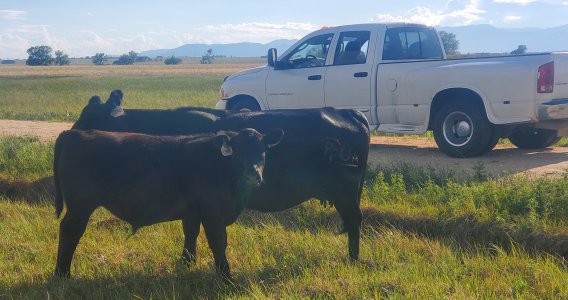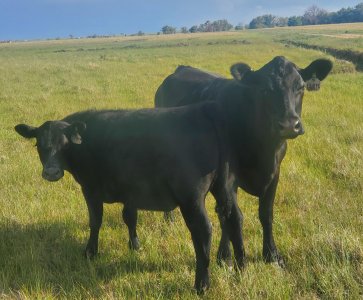Hi all,
I'm extremely new to cattle, but have lived on a farm all my life. I am looking at hosting weddings on my property, and have decided on longhorn cattle for marketing purposes. My question to you all is what would produce the best quality beef cow in this situation, and can you guarantee that they retain their horns in crosses by going 3/4 longhorn 1/4 other? From what I've read in other threads/forums it seems like at a 50/50 cross it is a guessing game if they will be polled or not, is that true and would adding more longhorn help that issue? The other issue is beef quality/quantity.
I understand that longhorn meat is healthier, but their feed conversion is much worse. I"m looking at crossing the cattle for this reason. Will crossing the longhorns with a fattier breed - like Angus - ruin the health benefits, or would the difference in fat content be negligible? I'm assuming LH X CHAR would grow quicker than LH X ANGUS and the former seems to be the preference on here?
I will be looking at doing direct sales the first few years so dressed out weight is not the biggest issue, I am more looking at pure flavour/tenderness/quality.
Thanks in advance for any help

Pic 1: 5 month old steer that's 25% LH and 75% ANG. His dam is behind him (50% LH and 50% ANG)
Pic 2: 8.5 mo old heifer 25% LH, and her dam that's 50/50
Sigh...I start to get a little agitated with the polled, scur, and AH gene discussions on here. If you don't understand genetics, you shouldn't comment on things you don't understand.
It is genetically impossible to get a single horned calf if you use a Homo Polled Bull (PP) on a Horned Cow (pp) or a horned bull on a homo polled cow (AH Gene excepted). If you're running an Angus Bull on a LH cow you don't have to worry about the African Horned Gene anyway. Generation 1 you will get all Hetero Polled offspring (Pp), Generation 2 you will have 50% Hetero Polled, 50% Homo Polled. They will all be polled regardless. Scurs are a completely separate gene. The phenotypical expression of Scurs is influenced by the Polled gene, but scurs is a completely different gene. A homo polled cow or bull (AH gene excepted) will always, 100% of the time produce polled offspring. If you get anything else, you don't have a homo polled bull or cow. Period.
One of the most successful grass-fed operations here locally that direct markets is 100% LH. Caustic has pretty much been consistent in his opinion...and If you use the wrong bulls and the wrong cows these guys are absolutely right. If you use the right bulls and right cows you will have a phenomenal herd and you will not take a hit at the sale barn. I should know. I just sold calves in December that were 12.5%-25% LH and they came close to topping the market...the year before the same...the year before the same. When I grass finish they grade choice or above.
The health, fertility, growth, hardiness, calving ease, intelligence, disposition, and disease resistance traits of having longhorn influence in your herd is unbeatable for my environment and operation. I have an 1150ish lb cow that is 50% LH that is almost 18 years old now. She is the first one to calve, first one to breed back, and she weans a 600lb calf pretty consistently. I don't care how you run the numbers...I'll put the profitability of that cow against anyone's. I've had "great" genetic pure angus and hereford and traditional crosses that came from higher rainfall areas of Colorado. When they came down here they fell apart within a month while my cows were gaining and getting fat. My cows perform excellent on crappy forage, and they blow up and gain like crazy on good grass and grain. Feed Efficiency and conversion is undervalued by people in higher rainfall areas. One of my repeat private treaty customers grain finishes and the last group he finished graded choice with a few grading prime....I don't really care what anyone's opinion is compared to fact.
My calves averaged around 2 lbs ADG this year with mineral and grass (calculated on sale day after 45 days of weaning). The area they are pictured in is a small sub irrigated area, the rest of the pasture is dead and brown. This year became a pretty bad drought year (D-4 from the FSA). I'm more than happy with that performance in a drought with little to no inputs on my part. My cows are great mamas, easy fleshing, wean great calves that sell well and have some of the best disposition I've seen. Zero calving issues ever.
That said...you can't just hodgepodge things together. You need to have a plan and select cows and bulls that fit that plan.
1. Get solid red / Solid black LH cows. The fancy colors are pretty but won't fit what you're trying to do.
2. Get LHs that are beefier, and raised by an operation that doesn't pamper them. I source my LHs from a guy locally that raises beefier longhorns that are raised with little inputs and expected to survive and thrive on the same forage as mine with little input. By sourcing that way, I benefit from his 40+ years of selection and breeding and get the traits I want. Then I go through and select based on the phenotype I want and disposition.
3. Select angus bulls that compliment what you're trying to do. My must haves for selection are thickness, muscling, marbling, and disposition. There's other traits and specific phenotypes I look for, but those are the main ones.
4. Cull hard and often.
I've also run a Hereford bull (I like the old world type) on the 50% and 75% cows with excellent results. The 50% have more variation in the calf crop than I like, but dang they grow like crazy and they have sold well even with the variation.
I've worked a lot of different breeds of cattle here and down south. I wouldn't trade my cows for any of them....but I'm a little biased.
What you want to do can be done...and it can be done profitably. Most of that depends on you, your plan, your environment, and your management and marketing decisions. Anyone who wants to argue with that, can argue with my bank account and sales receipts.




